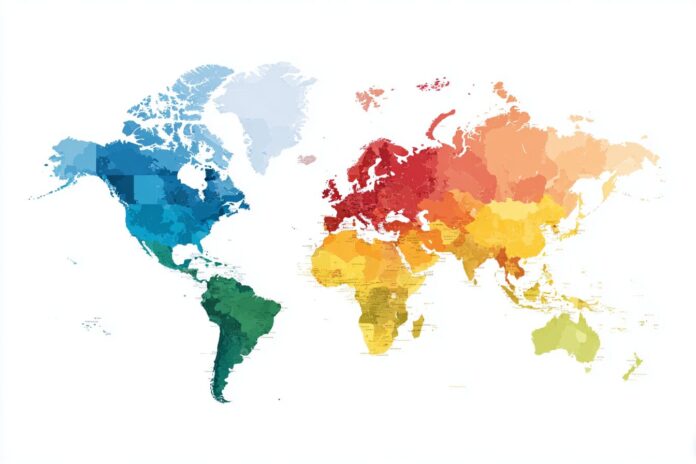In June 2025, mobile devices drove 64% of all global web traffic, marking a new milestone and the eighth consecutive quarter of growth. This share has more than doubled since 2015 when smartphones and tablets accounted for just 31.16% of online interactions. The rapid surge underlines how mobile has firmly overtaken desktop, reshaping the way users browse, shop, and consume content on the web.
According to data aggregated by TechSpot, Android stands at the forefront of this shift. Google’s OS commands a 72.72% share of the mobile web market, while Apple’s iOS trails behind with 26.92%. Other platforms—such as Samsung’s Tizen, KaiOS, and Linux-based systems—together contribute less than 1% of global mobile browsing traffic, highlighting Android’s dominant position.
Regional Breakdown: Asia Leads, Europe and Americas Follow
Mobile adoption varies widely by region. In Asia, smartphones generate 71.3% of web traffic—well above the global average. This high figure reflects fast-growing economies, rapid 4G/5G rollouts, and a mobile-first mentality among consumers. In contrast, Europe and the Americas each hover around 50% mobile share, indicating that desktop remains more entrenched in these markets.
Key factors influencing regional trends include:
- Network Infrastructure: Countries in Asia and Africa have leapfrogged older networks, deploying 5G and advanced 4G at scale. These upgrades have made mobile browsing faster and more reliable, encouraging users to favor smartphones over desktops.
- Device Affordability: Budget-friendly Android handsets with solid performance have widened internet access in emerging regions. Manufacturers like Xiaomi, Realme, and Samsung offer multi-band support and powerful CPUs at accessible price points.
- Mobile-First Culture: In many developing economies, users bypassed desktop PCs altogether, using smartphones for essential tasks—banking, e-commerce, and social media—from day one.
Despite slower adoption, Western markets still exhibit significant mobile engagement. Strong desktop legacies, larger screens, and regional habits mean that businesses must optimize for both platforms.
Why Android Commands the Mobile Web
Android’s dominance on the mobile web stems from several strategic advantages:
- Device Diversity: Android powers a vast range of devices—from entry-level phones under $100 to flagship gaming handsets with advanced cooling systems. This variety meets diverse consumer needs and price points.
- Open-Source Ecosystem: OEMs customize Android to local preferences, adding features like dual-SIM support, regional app stores, and language packs. This flexibility spurs adoption and innovation.
- Global Distribution: Android holds a strong presence in populous markets like India, China, and Southeast Asia, where consumers prioritize cost-effective connectivity over flagship branding.
By contrast, iOS’s popularity remains concentrated in high-income regions such as North America, Western Europe, and parts of East Asia. Apple’s premium pricing and closed ecosystem ensure consistent quality but limit market penetration in cost-sensitive markets.
Business and Developer Implications: Mobile-First is Non-Negotiable
With mobile now accounting for nearly two-thirds of web traffic, companies must align their strategies accordingly:
- Embrace Responsive Design: Every page must adapt seamlessly to various screen sizes and orientations. Use fluid grids, flexible images, and CSS media queries to maintain usability.
- Focus on Speed and Performance: Mobile users expect instant loading, even on cellular networks. Implement code minification, compress images, leverage browser caching, and deploy Content Delivery Networks (CDNs).
- Adopt Progressive Web Apps (PWAs): PWAs deliver app-like experiences—offline support, push notifications, and home-screen installation—while retaining the discoverability and cross-platform reach of web apps.
- Optimize for Android Features: Tap into Android-specific capabilities such as Adaptive Icons, WebAPK, and custom share intents. Tailoring UX for Android’s ecosystem can boost engagement and retention.
Neglecting mobile optimization risks higher bounce rates, lost sales, and lower search engine rankings. This shift demands cross-functional collaboration between design, development, and marketing teams.
Emerging Trends: AI, Voice, and Micro-Interactions
Beyond basic optimization, mobile web evolution is being driven by:
- AI-Powered Personalization: Machine learning models analyze user behavior to tailor content, product recommendations, and UI adjustments in real time. This level of customization enhances user satisfaction and conversion rates.
- Voice Search and Commands: As smart assistants and speech recognition improve, optimizing for voice queries becomes crucial. Long-tail keywords, natural language structures, and concise FAQ sections can capture voice-driven traffic.
- Micro-Interactions: Subtle animations—like button presses, loading skeletons, and scroll-triggered effects—create a sense of responsiveness and delight, keeping users engaged during brief pauses.
These innovations require developers to integrate AI frameworks, implement semantic HTML, and fine-tune frontend libraries for efficiency.
Future Outlook: Towards 70%+ Mobile Share
Analysts predict that mobile’s global web traffic share will surpass 70% by early 2026. Factors fueling this growth include expanding 5G, increasing smartphone penetration, and the rise of mobile-centric services like mobile banking, on-demand video streaming, and social commerce.
Moreover, the integration of mobile wallets and digital IDs will deepen the mobile web’s role in everyday transactions. As users grow more comfortable with mobile-first solutions—ridesharing, telehealth, and micro-payments—businesses that streamline mobile experiences will gain a competitive edge.
In conclusion, the era of mobile-first has graduated to mobile-dominant. For developers, marketers, and product managers, the charge is clear: prioritize mobile at every stage of design and deployment to capture the majority of online audiences.



